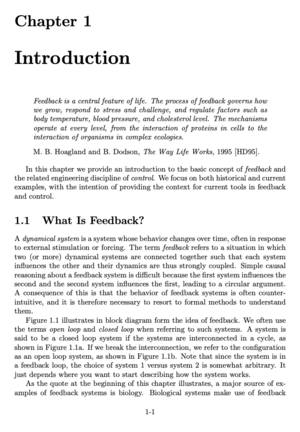Difference between revisions of "Introduction"
| Line 45: | Line 45: | ||
{{Chapter footer | {{Chapter footer | ||
| − | | First edition URL= | + | | First edition URL=https://www.cds.caltech.edu/~murray/amwiki/Introduction.html |
| Additional information= | | Additional information= | ||
* [https://lewisgroup.uta.edu/history.htm A Brief History of Feedback Control] (from F.L. Lewis, Applied Optimal Control and Estimation, Prentice-Hall, 1992) | * [https://lewisgroup.uta.edu/history.htm A Brief History of Feedback Control] (from F.L. Lewis, Applied Optimal Control and Estimation, Prentice-Hall, 1992) | ||
Revision as of 04:22, 8 April 2024
| Prev: Preface | Chapter 1 - Introduction | Next: Feedback Principles |
In this chapter we provide an introduction to the basic concept of feedback and the related engineering discipline of control. We focus on both historical and current examples, with the intention of providing the context for current tools in feedback and control.
Contents
- What Is Feedback?
- What is Feedforward?
- What Is Control?
- Uses of Feedback and Control
- Feedback Properties
- Simple Forms of Feedback
- Combining Feedback with Logic
- Cruise control
- Server Farms
- Air--Fuel Control
- Control System Architectures
- Freight Train Trip Optimizer
- Process Control Systems
- Autonomous Driving
- Further Reading
- Exercises
Chapter Summary
This chapter provides an overview of the role of feedback in science and engineering.
-
Feedback is defined as the interaction of two (or more) dynamical systems that are connected together such that each system influences the other and their dynamics are thus strongly coupled. We say that a system is closed loop if the systems are interconnected in a cycle and open loop when this interconnection is broken.
-
Control is defined as the use of algorithms and feedback in engineered systems. The basic feedback loop of sensing, computation and actuation is the central concept in control. The key issues in designing control logic are ensuring that the dynamics of the closed loop system are stable (bounded disturbances give bounded errors) and that they have the desired behavior (good disturbance rejection, fast responsiveness to changes in operating point, etc).
-
Examples of feedback systems can be found all around us, ranging from early examples such as thermostats in buildings and cruise control in automobiles, to modern engineering examples such as aircraft flight control, electronic amplifiers, chemical process control and the Internet. Feedback is also present throughout nature, including biological systems, ecosystems, and the global environment.
-
Two key properties of feedback are its ability to provide robustness to uncertainty and its use in design of dynamics. By measuring the difference between a signal's actual and desired values, we can provide a corrective action. This action can maintain the desired operation of a system even when there are changes in the parameters governing the dynamics of the system, and can also be used to modify the natural (open loop) dynamics of a system.
-
Feedback also has potential drawbacks: it can cause instability if not used properly and it can couple noise from sensors into the dynamics of a system. It can also increase the overall complexity of a system by coupling different parts of a system so that their dynamics are dependent on one another.
An example of one of the most common feedback controllers is the PID controller, consisting of proportional, integral and derivative terms:
The proportional term provides a restoring input in the presence of error but on its own does not force the error to zero. Integral action provides a mechanism for ensuring that the error is zero in steady state. The derivative term provides an anticipatory feedback that predicts future error by making use of the derivative.

